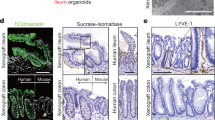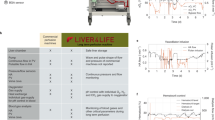Abstract
We determine here the functional integrity of auxiliary livers in containers fashioned from the small intestine. Liver microfragments from dipeptidyl peptidase 4 (DPP4)-deficient rats were transplanted into syngeneic normal animals with isolated intestinal segments characterized by mucosal denudation but intact vascular supply. Transplanted liver fragments were restored to confluent tissue with normal hepatic architecture and development of DPP4-positive vessels, indicating angiogenesis and revascularization. Auxiliary liver units expressed multiple hepatotrophic and angiogenic genes, and transplanted tissues remained intact for up to the 6-week duration of the studies with neither ischemic injury nor significant hepatocellular proliferation. Hepatic metabolic, transport and synthetic functions were preserved in auxiliary livers, including uptake and biliary excretion of 99mTc-mebrofenin in syngeneic recipients of liver from F344 rats, as well as secretion of albumin in allografted Nagase analbuminemic rats. This ability to produce functionally competent auxiliary livers in vascularized intestinal segments offers therapeutic potential for liver disease and genetic deficiency.
This is a preview of subscription content, access via your institution
Access options
Subscribe to this journal
Receive 12 print issues and online access
$209.00 per year
only $17.42 per issue
Buy this article
- Purchase on Springer Link
- Instant access to full article PDF
Prices may be subject to local taxes which are calculated during checkout





Similar content being viewed by others
References
Kayler, L.K. et al. Long-term survival after liver transplantation in children with metabolic disorders. Pediatr. Transplant. 6, 295–300 (2002).
Azoulay, D. et al. Auxiliary partial orthotopic versus standard orthotopic whole liver transplantation for acute liver failure: a reappraisal from a single center by a case-control study. Ann. Surg. 234, 723–731 (2001).
Kiuchi, T. et al. Auxiliary liver transplantation for urea-cycle enzyme deficiencies: lessons from three cases. Transplant. Proc. 31, 528–529 (1999).
Rela, M. et al. Auxiliary partial orthotopic liver transplantation for Crigler–Najjar syndrome type I. Ann. Surg. 229, 565–569 (1999).
Angelis, M., Pegelow, C.H., Khan, F.A., Verzaro, R. & Tzakis, A.G. En bloc heterotopic auxiliary liver and bilateral renal transplant in a patient with homozygous protein C deficiency. J. Pediatr. 138, 120–122 (2001).
Haberal, M. et al. Successful heterotopic segmental liver transplantation from a live donor to a patient with Alagille syndrome. J. Pediatr. Surg. 36, 667–671 (2001).
Durand, F. et al. Auxiliary liver transplantation for fulminant hepatitis B: Results from a series of six patients with special emphasis on regeneration and recurrence of hepatitis B. Liver Transpl. 8, 701–707 (2002).
Kaibori, M. et al. Selective portal blood flow diversion in auxiliary partial orthotopic liver transplantation to induce regeneration of the graft. Transplantation 66, 935–937 (1998).
de Jonge, J. et al. Directing portal flow is essential for graft survival in auxiliary partial heterotopic liver transplantation in the dog. J. Pediatr. Surg. 34, 1265–1268 (1999).
Gupta, S. & Roy Chowdhury, J. Hepatocyte transplantation: Back to the future! Hepatology 15, 156–162 (1992).
Sundback, C.A. & Vacanti, J.P. Alternatives to liver transplantation: from hepatocyte transplantation to tissue-engineered organs. Gastroenterology 118, 438–442 (2000).
Berishvili, E. et al. Generation of heterotopic liver in an isolated and vascularized segment of the small intestine in rats. Transplantation 75, 1827–1832 (2003).
Gaglio, P.J. et al. Liver regeneration investigated in a non-human primate model (Macaca mulatta). J. Hepatol. 37, 625–632 (2002).
Gupta, S., Rajvanshi, P. & Lee, C.-D. Integration of transplanted hepatocytes in host liver plates demonstrated with dipeptidyl peptidase IV deficient rats. Proc. Natl. Acad. Sci. USA 92, 5860–5864 (1995).
Malhi, H. et al. 99mTc-mebrofenin scintiscanning for evaluating liver disease in a rat model of Wilson's disease. J. Nucl. Med. 43, 246–252 (2002).
Rajvanshi, P., Kerr, A., Bhargava, K.K., Burk, R.D. & Gupta, S. Studies of liver repopulation using the dipeptidyl peptidase IV-deficient rat and other rodent recipients: cell size and structure relationships regulate capacity for increased transplanted hepatocyte mass in the liver lobule. Hepatology 23, 482–496 (1996).
Robotin-Johnson, M.C., Swanson, P.E., Johnson, D.C., Schuessler, R.B. & Cox, J.L. An experimental model of small intestinal submucosa as a growing vascular graft. J. Thorac. Cardiovasc. Surg. 116, 805–811 (1998).
Yla-Herttuala, S. & Alitalo, K. Gene transfer as a tool to induce therapeutic vascular growth. Nat. Med. 9, 694–695 (2003).
Ferrara, N., Gerber, H.P. & LeCouter, J. The biology of VEGF and its receptors. Nat. Med. 9, 669–676 (2003).
Cleaver, O. & Melton, D.A. Endothelial signaling during development. Nat. Med. 9, 661–668 (2003).
Selden, C. et al. Histidinemia in mice: a metabolic defect treated using a novel approach to hepatocellular transplantation. Hepatology 21, 1405–1412 (1995).
Powell, D.W. et al. Myofibroblasts. II. Intestinal subepithelial myofibroblasts. Am. J. Physiol. 277, C183–C201 (1999).
LeCouter, J. et al. Angiogenesis-independent endothelial protection of liver: role of VEGFR-1. Science 299, 890–893 (2003).
Suzuki, S. et al. Skeletal muscle injury induces hepatocyte growth factor expression in spleen. Biochem. Biophys. Res. Commun. 292, 709–714 (2002).
Oh, S.H. et al. Hepatocyte growth factor induces differentiation of adult rat bone marrow cells into a hepatocyte lineage in vitro. Biochem. Biophys. Res. Commun. 279, 500–504 (2000).
Scotte, M. et al. Cytokine gene expression in liver following minor or major hepatectomy in rat. Cytokine 9, 859–867 (1997).
Kalyani, A.J., Mujtaba, T. & Rao, M.S. Expression of EGF receptor and FGF receptor isoforms during neuroepithelial stem cell differentiation. J. Neurobiol. 38, 207–224 (1999).
Zhao, H., Patra, A., Tanaka, Y., Li, L.C. & Dahiya, R. Transforming growth factor-β(s) and their receptors in aging rat prostate. Biochem. Biophys. Res. Commun. 294, 464–469 (2002).
Ishii, H., Oota, I., Arakawa, T. & Takuma, T. Differential gene expression of vascular endothelial growth factor isoforms and their receptors in the development of the rat masseter muscle. Arch. Oral. Biol. 47, 505–510 (2002).
Haggstrom Rudolfsson, S., Johansson, A., Franck Lissbrant, I., Wikstrom, P. & Bergh, A. Localized expression of angiopoietin 1 and 2 may explain unique characteristics of the rat testicular microvasculature. Biol. Reprod. 69, 1231–1237 (2003).
Acknowledgements
We thank C. Zhang for technical assistance. This work was supported in part by NIH grants R01 DK46952 and P30-DK-41296 and by grant G-362 from the International Scientific Technology Center, Moscow, Russia.
Author information
Authors and Affiliations
Corresponding author
Ethics declarations
Competing interests
The authors declare no competing financial interests.
Rights and permissions
About this article
Cite this article
Joseph, B., Berishvili, E., Benten, D. et al. Isolated small intestinal segments support auxiliary livers with maintenance of hepatic functions. Nat Med 10, 749–753 (2004). https://doi.org/10.1038/nm1057
Received:
Accepted:
Published:
Issue Date:
DOI: https://doi.org/10.1038/nm1057
This article is cited by
-
Silencing of hepatic fate-conversion factors induce tumorigenesis in reprogrammed hepatic progenitor-like cells
Stem Cell Research & Therapy (2016)
-
A Novel Endoscopic Bariatric Procedure: Results of an Experimental Study
Obesity Surgery (2016)
-
Transdisciplinary approach to restore pancreatic islet function
Immunologic Research (2013)
-
Potential of bioengineering processes for therapeutic repopulation of the liver with cells
Biotechnology and Bioprocess Engineering (2007)



